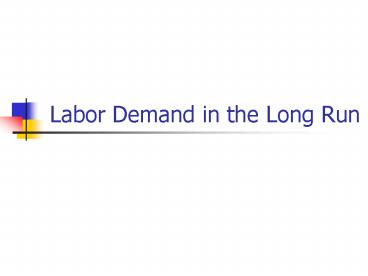Labor Demand in the Long Run PowerPoint PPT Presentation
Title: Labor Demand in the Long Run
1
Labor Demand in the Long Run
2
The long run
- in the long run, all inputs are variable,
- model used in discussion has 2 inputs L (labor)
and K (capital). - Q f(L,K)
- isoquant - a graph that contains all of the
combinations of inputs that result in a given
level of output.
3
Isoquant
4
Isoquant
5
Isoquants
6
Marginal rate of technical substitution
The marginal rate of technical substitution of L
for K (MRTS) is defined as the additional amount
of capital needed to replace a unit of labor,
holding output constant. Mathematically, the MRTS
can also be expressed as
7
Law of diminishing MRTS
- Law of diminishing MRTS the MRTS declines as
the level of labor use rises along an isoquant
(i.e., isoquant curves are convex)
8
Alternative derivation of the MRTS
Along an isoquant
With a little manipulation
More precisely
Or
9
Isocost curves
TC wL cK where TC total cost w wage c
price of capital L quantity of labor K
quantity of capital
In slope-intercept form, this equation becomes K
(-w/c)L (TC/c)
10
Isocost curve
11
Isocost curves
12
Cost minimization
13
Cost-minimization rule
- cost minimization occurs when an isocost curve is
tangent to the isoquant - -MRTS -w/c
- MRTS w/c
14
Substitution and scale effects
- the substitution effect associated with a change
in the wage rate is the change in the mix of
inputs that results from the change in relative
prices, holding output constant. - the scale effect is the change in the mix of
inputs that occurs because of the change in the
level of output resulting from a change in factor
prices, holding relative factor prices constant.
15
Substitution effect
16
Scale effect
PowerShow.com is a leading presentation sharing website. It has millions of presentations already uploaded and available with 1,000s more being uploaded by its users every day. Whatever your area of interest, here you’ll be able to find and view presentations you’ll love and possibly download. And, best of all, it is completely free and easy to use.
You might even have a presentation you’d like to share with others. If so, just upload it to PowerShow.com. We’ll convert it to an HTML5 slideshow that includes all the media types you’ve already added: audio, video, music, pictures, animations and transition effects. Then you can share it with your target audience as well as PowerShow.com’s millions of monthly visitors. And, again, it’s all free.
About the Developers
PowerShow.com is brought to you by CrystalGraphics, the award-winning developer and market-leading publisher of rich-media enhancement products for presentations. Our product offerings include millions of PowerPoint templates, diagrams, animated 3D characters and more.

